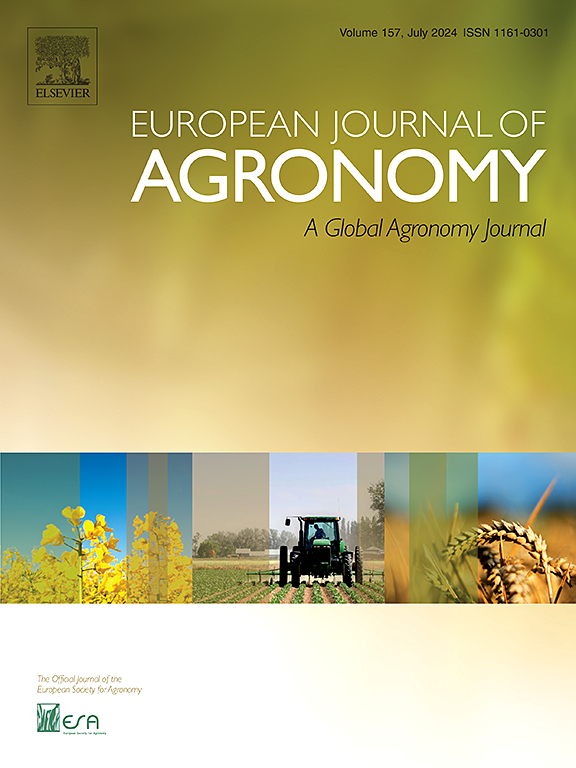Meta-analysis reveals that returning crop straw to arable land causes soil acidification at the global scale
IF 4.5
1区 农林科学
Q1 AGRONOMY
引用次数: 0
Abstract
Returning crop straw to arable lands has been recommended as an appealing practice of climate-smart agriculture. On the other hand, straw return (SR) may also change soil pH that crucially regulates soil productivity and environmental quality. However, the magnitude and controlling factors of this SR-induced soil pH change remain largely uncertain, limiting our ability to fully assess its impacts on soil health and environmental quality. Here, we conducted an integrative synthesis of SR-induced soil pH change using a database comprising 326 treatment-pairs at 175 sites across the globe. Overall, SR caused significant (P < 0.01) decline in soil pH, with an average magnitude of −0.030 ± 0.024 (95 % confidence interval, CI) units and an annual change rate of −0.015 ± 0.006 (95 % CI) units, compared with the non-SR reference. Specifically, SR-induced soil pH change varied substantially with local agricultural managements and environmental conditions, of which initial soil pH and land use type were identified as the two most-important factors. Straw return decreased soil pH in alkaline soils but increased pH in acidic soils, leading to a negative correlation between SR-induced soil pH change and its initial value. Straw return caused soil pH decline both in dry and paddy lands, while the decline magnitude in paddy lands was twice as large as in dry lands. By highlighting the risk of SR-induced soil acidification, our results provide new insights to evaluate the agro-environmental consequences of straw return practice, which will help to develop the region-specific tailored straw utilization policies.
meta分析表明,在全球尺度上,秸秆还田导致土壤酸化
将农作物秸秆还田作为气候智能型农业的一项颇具吸引力的实践被推荐。另一方面,秸秆还田还可能改变土壤pH值,而pH值对土壤生产力和环境质量起着至关重要的调节作用。然而,sr引起的土壤pH值变化的幅度和控制因素在很大程度上仍然不确定,限制了我们全面评估其对土壤健康和环境质量影响的能力。在这里,我们使用一个包含全球175个地点的326个处理对的数据库,对sr诱导的土壤pH变化进行了综合合成。总体而言,与非SR对照相比,SR引起土壤pH显著(P <; 0.01)下降,平均幅度为- 0.030 ± 0.024(95 %置信区间,CI)单位,年变化率为- 0.015 ± 0.006(95 % CI)单位。具体而言,sr诱发的土壤pH值变化与当地农业管理和环境条件有很大差异,其中初始土壤pH值和土地利用类型是两个最重要的因素。秸秆还田降低了碱性土壤的pH值,提高了酸性土壤的pH值,导致sr诱导的土壤pH值变化与其初始值呈负相关。秸秆还田导致旱地和水田土壤pH值下降,且水田土壤pH值下降幅度是旱地的2倍。通过突出sr诱导土壤酸化的风险,我们的研究结果为评估秸秆还田实践的农业环境后果提供了新的见解,这将有助于制定有针对性的秸秆利用政策。
本文章由计算机程序翻译,如有差异,请以英文原文为准。
求助全文
约1分钟内获得全文
求助全文
来源期刊

European Journal of Agronomy
农林科学-农艺学
CiteScore
8.30
自引率
7.70%
发文量
187
审稿时长
4.5 months
期刊介绍:
The European Journal of Agronomy, the official journal of the European Society for Agronomy, publishes original research papers reporting experimental and theoretical contributions to field-based agronomy and crop science. The journal will consider research at the field level for agricultural, horticultural and tree crops, that uses comprehensive and explanatory approaches. The EJA covers the following topics:
crop physiology
crop production and management including irrigation, fertilization and soil management
agroclimatology and modelling
plant-soil relationships
crop quality and post-harvest physiology
farming and cropping systems
agroecosystems and the environment
crop-weed interactions and management
organic farming
horticultural crops
papers from the European Society for Agronomy bi-annual meetings
In determining the suitability of submitted articles for publication, particular scrutiny is placed on the degree of novelty and significance of the research and the extent to which it adds to existing knowledge in agronomy.
 求助内容:
求助内容: 应助结果提醒方式:
应助结果提醒方式:


